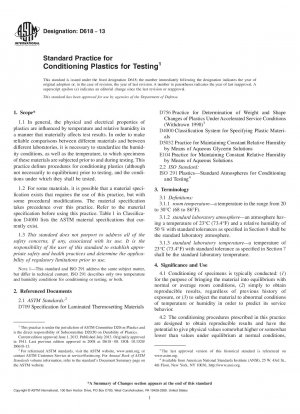ASTM D618-13
Standard Practice for Conditioning Plastics for Testing
- Standard No.
- ASTM D618-13
- Release Date
- 2013
- Published By
- American Society for Testing and Materials (ASTM)
- Status
- Replace By
- ASTM D618-21
- Latest
- ASTM D618-21
- Scope
4.1 Conditioning of specimens is typically conducted: (1) for the purpose of bringing the material into equilibrium with normal or average room conditions, (2) simply to obtain reproducible results, regardless of previous history of exposure, or (3) to subject the material to abnormal conditions of temperature or humidity in order to predict its service behavior.
4.2 The conditioning procedures prescribed in this practice are designed to obtain reproducible results and have the potential to give physical values somewhat higher or somewhat lower than values under equilibrium at normal conditions, depending upon the particular material and test. Depending on the thickness, type of material and its previous history, it is possible that it would take 20 to 100 days or more to ensure substantial equilibrium under normal conditions of humidity and temperature. Consequently, conditioning for reproducibility must of necessity be used for general purchase specifications and product control tests.
1.1 In general, the physical and electrical properties of plastics are influenced by temperature and relative humidity in a manner that materially affects test results. In order to make reliable comparisons between different materials and between different laboratories, it is necessary to standardize the humidity conditions, as well as the temperature, to which specimens of these materials are subjected prior to and during testing. This practice defines procedures for conditioning plastics (although not necessarily to equilibrium) prior to testing, and the conditions under which they shall be tested.
1.2 For some materials, it is possible that a material specification exists that requires the use of this practice, but with some procedural modifications. The material specification takes precedence over this practice. Refer to the material specification before using this practice. Table8201;1 in Classification D4000 lists the ASTM material specifications that currently exist.
ASTM D618-13 Referenced Document
- ASTM D4000 Standard Classification System for Specifying Plastic Materials
- ASTM D5032 Standard Practice for Maintaining Constant Relative Humidity by Means of Aqueous Glycerin Solutions
- ASTM D709 Standard Specification for Laminated Thermosetting Materials*, 2024-04-20 Update
- ASTM D756 Standard Specification for Aviation Turbine Fuel Containing Synthesized Hydrocarbons
- ASTM E104 Standard Practice for Maintaining Constant Relative Humidity by Means of Aqueous Solutions
- ISO 291 Plastics - Standard atmospheres for conditioning and testing
ASTM D618-13 history
- 2021 ASTM D618-21 Standard Practice for Conditioning Plastics for Testing
- 2013 ASTM D618-13 Standard Practice for Conditioning Plastics for Testing
- 2008 ASTM D618-08 Standard Practice for Conditioning Plastics for Testing
- 2005 ASTM D618-05 Standard Practice for Conditioning Plastics for Testing
- 2000 ASTM D618-00 Standard Practice for Conditioning Plastics for Testing
